Free Online Productivity Tools
i2Speak
i2Symbol
i2OCR
iTex2Img
iWeb2Print
iWeb2Shot
i2Type
iPdf2Split
iPdf2Merge
i2Bopomofo
i2Arabic
i2Style
i2Image
i2PDF
iLatex2Rtf
Sci2ools
FPGA
2009
ACM
2009
ACM
Wirelength modeling for homogeneous and heterogeneous FPGA architectural development
This paper describes an analytical model that relates the architectural parameters of an FPGA to the average prerouting wirelength of an FPGA implementation. Both homogeneous and heterogeneous FPGAs are considered. For homogeneous FPGAs, the model relates the lookup-table size, the cluster size, and the number of inputs per cluster to the expected wirelength. For heterogeneous FPGAs, the number and positioning of the embedded blocks, as well as the number of pins on each embedded block is considered. Two applications of the model to FPGA architectural design are also presented. Categories and Subject Descriptors B.7.1 [Types and Design Styles]: Gate arrays General Terms Design, Theory
Embedded Block | FPGA | FPGA 2009 | Hardware | Heterogeneous Fpgas |
| Added | 19 May 2010 |
| Updated | 19 May 2010 |
| Type | Conference |
| Year | 2009 |
| Where | FPGA |
| Authors | Alastair M. Smith, Steven J. E. Wilton, Joydip Das |
Comments (0)

